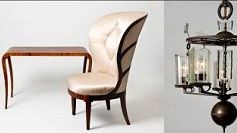
Press release -
New acquisition: An armchair, table, and candelabra from the Paris Exhibition of 1925
The Nationalmuseum’s collection of applied art and modern design has gained an armchair, a table and candelabra from the International Exposition of Modern Industrial and Decorative Arts in Paris in 1925. The acquisition is an important addition to the collections as several pieces from the period is missing.
The Swedish pavilion was designed by Carl Bergsten and furnished with objects that can be categorised as “Art Deco”, a style that took its name from the event’s French title Exposition internationale des Arts décoratifs et industriels modernes. The exhibition was instrumental in launching Swedish art and design onto the international stage.
With 20th-century Modernist historians and museum curators often tending to dismiss this type of exclusive object as decadent, the Nationalmuseum is missing several key pieces from the Swedish pavilion in Paris in 1925, which makes this new acquisition an important addition to the collection.
The candelabra in bronze and glass was designed by Carl Bergsten for the reception hall. It was made by Nordiska Kompaniet’s workshops as a distinctly luxury item. Drawings of the pavilion show two candelabras, but there is only one in photographs from the time, most probably the one that the museum has now acquired.
Architect Uno Åhrén was responsible for the ladies’ drawing room or “boudoir” from which the armchair and table originate. The interior was much criticised after the event, not least by Åhrén himself. At the Paris Exhibition, he saw Le Corbusier’s Modernistic building L’Esprit Nouveau and realised that the modern industrial age demanded a different approach to design and production. In an article for the journal Form in 1925, he criticised “decoration on every millimetre of existence” and urged artists and designers to serve the nation by creating anonymous furniture and functional objects. However, Åhrén’s own critique does nothing to diminish our appreciation of his painstaking interior design for this exclusive room.
This acquisition was made possible through a generous donation by Barbro Osher, through her Pro Suecia Foundation. The Nationalmuseum has no funds of its own with which to acquire art and design, and so relies on gifts and funds from private foundations to expand its collection.
The acquisition can be seen at the floor for applied art and modern design in the museum.
Further information
Anders Bengtsson, Curator, abn@nationalmuseum.se, +46 8 5195 4385
Press images
Hanna Tottmar, Press Officer, htr@nationalmuseum.se, +46 8 5195 4390, +46 767 23 46 32
Captions
Uno Åhrén, Armchair and table; Carl Bergsten, Candelabra; Interior from the Paris Exhibition 1925 (photo from Svensk Form’s archive)

